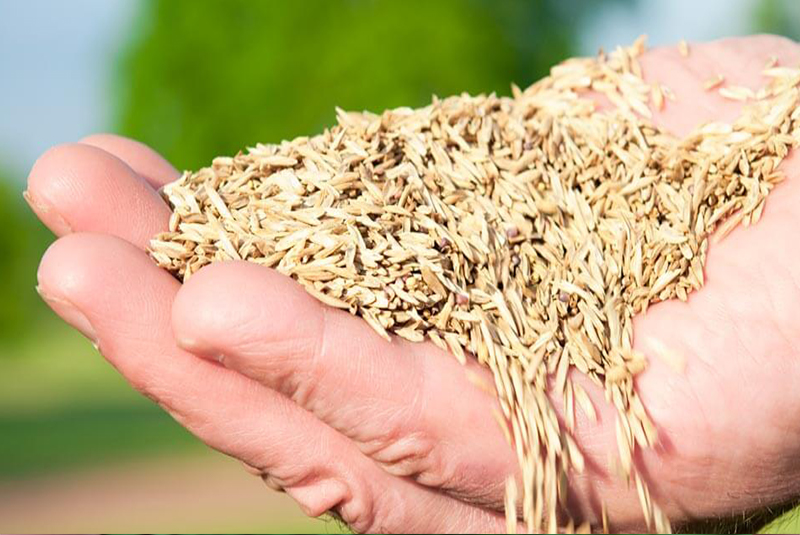The turfgrass seed industry continues to be a vital component of landscaping, sports and residential projects as the market is still experiencing a steady demand for these services. Ongoing maintenance of these spaces has continued to show similar signs of steady demand supporting the professional lawn and landscape services market in 2024 to date. Despite this, the current state of the turfgrass seed market finds itself navigating a complex situation shaped by several key factors, including supply, acres planted, and evolving consumer preferences.
Supply
The supply is strong. Looking back to 2022, the turfgrass seed industry experienced a historically large crop. That large crop year of 2022 and the average crop year of 2023, paired with industry usage going back down to pre-Covid era numbers has slowed to normalized the movement of seed in markets. Couple that with just an average Fall 2023 seeding market due to wetter than normal conditions in July and August through key parts of the country, as well as an average Spring 2024 seeding market has kept supply levels strong.
To add to that, the crop for 2024 is looking good as indicated by several of Central’s key seed supplier harvest reports. So, what does this mean? For the most part (outside of specific varieties) supply heading into the Fall 2024 seeding market is in a good spot. As a result of this abundant supply and normalized demand right now, market dynamics have adjusted accordingly in the seed markets. Due to these conditions, it may present an opportunity to further explore seed options to better fit your business, program and more importantly the environmental growing conditions in which you operate your business. Please reach out to your local Central Turf and Irrigation Supply representative to discuss more!
Decreased Acreage
“Acreage of most Oregon seed crops are down sharply. The usual alternative crops are down as well, including the various vegetable crops grown in the Willamette Valley. Hazelnut prices have struggled recently, and new plantings of nut trees are down. A few growers are opting to leave some small acreage fallow. Others are planting crops like wheat or dry peas. The Oregon State Certification Service reports that total acres signed up for certification in 2024 are just 77% of the recent high in 2020. Perennial ryegrass acres are down more than 50% from a recent high in 2016 and tall fescue seed production acres are down 15% from 2020 levels. Of course, these certified acres make up only a portion of the total seed crop. There is no place that uncertified acres are reported. This makes understanding how certified acres relate to the total acres is one of the trickiest jobs for Oregon seed industry personnel”. – (DLF, North American Seed Production Report, 2024)
This shift in acreage planted for Turfgrass Seed comes as no surprise due to the current supply and demand situation discussed in the previous section. However, this will be something Central Turf and Irrigation will be monitoring closely for the seasons ahead as supply and demand continues leveling out and the volatile weather conditions many of the major Turfgrass Seed growing regions are experiencing from one growing season to the next can quickly change the market dynamics again in the turfgrass seed industry.
Evolving Consumer (Your Customers) Preferences
There is a growing demand for sustainable and eco-friendly turfgrass solutions. Consumers are in search of low-input and low-water use varieties. Seed producers are focusing their research and development efforts on creating turfgrass varieties that can withstand shifting environmental conditions while maintaining the aesthetic and functional qualities expected by consumers. Aside from that, exploring technology integration through enhanced seed coatings, pest-resistant varieties, and improved germination rates are just some of the innovations to have on your radar.
Beyond traditional applications in lawns and golf courses, turfgrass is finding new niches in urban green spaces, rooftop gardens, and even as a component in erosion control systems. This diversification is expanding the market and driving demand for specialized seed varieties. These are all great consumer (your customers) demand trends to explore and align your business with if this is an opportunity with your customer base. At Central Turf and Irrigation Supply we are here to help you explore these options and align solutions that best meet the needs of your customers and help support the success of your business!
Key Takeaways Heading into the 2024 Fall Seeding Market
1. Supply is strong– While seed supply will not be scarce in general this upcoming season, ensure you are still locking in your needs in a timely manner to have the product in time to not disrupt your businesses operation. At Central Turf and Irrigation Supply we have our 2024 Fall Seed Program going on now through August 31st. Please reach out to your local branch or representative to learn more about the program and how a partnership with Central can support your business.
2. Align Seed Solutions to Fit Your Program and Growing Environment– Explore what’s in the bag alongside your Central Turf and Irrigation supply representative. We can help align the right solution to meet your agronomic and/or business goals.
3. Explore Technologies and Enhancements to Satisfy Your Customers Preferences– customer preferences have changed, explore new innovations that can help elevate your customers’ experience when engaging with your business.
This article was written by Austin Marsteller, Central’s Turf Category Director, to discuss the state of the 2024 Fall Seed Market. Whether it is fall seed products, drainage, irrigation or other categories, Central can meet all of your needs as a green industry contractor.

